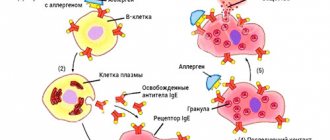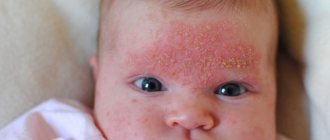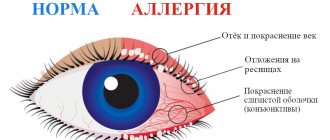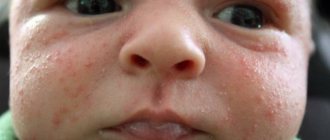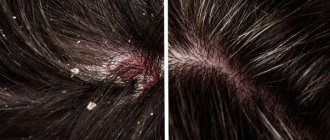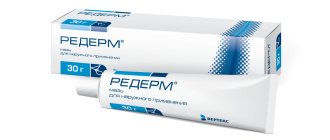Atopic dermatitis in children
Children's bodies are susceptible to many diseases, and one of the most common is atopic dermatitis. This inflammatory disease is allergic in nature and chronic in nature. Atopic dermatitis in children is expressed in peeling of the skin and itching, and is treated by an allergist.
What is atopic dermatitis?
This is a pathology of the epidermis, which is characterized by chronic immune inflammation. According to statistics, approximately every fifth child in the world experiences symptoms of atopic dermatitis. Most often, foci of inflammation develop in the area of the cheeks and folds, as well as in the area under the diaper.
The disease is characterized by a pronounced allergic nature and is associated with manifestations of immune dysfunction, which include food allergies, rhinitis, conjunctivitis, etc.
Lack of proper treatment can result in the development of severe forms of the disease. Also, neglect of qualified help threatens atopic march - a condition in which the disease “marches” throughout the baby’s body. This aggravates existing diseases and provokes the emergence of new ones. Contrary to misconceptions, atopic dermatitis in children does not go away with age.
Symptoms of atopic dermatitis in children
Symptoms of the disease depend on age. In this case, three phases are distinguished: infant, child and adult. The following symptoms are characteristic of each phase:
- symmetrical inflammation and redness
- dry skin that cannot be eliminated with cream
- severe itching causing discomfort
The disease has a direct connection with dysfunction of the epidermis. It is characterized by alternating periods of exacerbation with remissions. And, as a rule, in winter the situation worsens, and with the onset of the warm season, improvement is observed.
Stages of atopic dermatitis in children
There are two stages of the disease in accordance with the nature of the course, namely:
- acute - the skin becomes covered with rough red spots and papules, and crusts also appear, swelling is observed
- chronic - pigmentation on the skin of the eyelids increases, cracks form on the palms and soles, which is accompanied by thickening of the skin.
Causes of the disease
Dermatitis has a hereditary predisposition, and the main factor in its occurrence is genetic. If the parents have suffered from the disease, the probability of it developing in the child is about 80%.
In addition, the following causes that affect the mother’s body and fetal development can trigger the appearance of atopic dermatitis:
- unbalanced diet
- exposure to toxic substances
- infectious diseases
- regular stress
Children who have suffered oxygen deprivation or were born prematurely are also especially susceptible to atopic dermatitis.
Diagnosis and treatment of atopic dermatitis
Diagnosis can only be made by a dermatologist. As part of the examination, the specialist prescribes blood tests (general and biochemistry), urine analysis, skin biopsy, etc. In accordance with the research results, an individual treatment plan is prescribed.
Home treatment for goose bumps
To treat this disease, desire alone is not enough. To achieve the desired effect, you should also stock up on good patience and systematically carry out the necessary procedures. But few people can visit beauty salons on a regular basis.
Don’t be upset, as there are many ways that will tell you how to get rid of goose bumps at home:
A daily contrast shower will strengthen the walls of blood vessels and increase the tone of the epidermis.
Various wraps also have a very positive effect on the skin - they nourish and moisturize it. For wrapping you can use: chocolate, honey (if there is no allergy), seaweed.
Visiting a bathhouse or sauna (in the absence of individual contraindications). The body will respond to steam and water by activating blood supply even in the deepest layers of the epidermis, opening pores and removing toxins. It is worth noting that under the influence of high temperatures, the skin becomes dehydrated. Therefore, during and after visiting the bathhouse, you must drink water.
Diet. It is necessary to properly organize your nutrition. Avoid spicy, salty, sweet and fatty foods, or at least limit them to the maximum.
Daily consumption of fruits and vegetables will saturate the body with beneficial vitamins and organic acids. Regular drinking of clean water (at least 1.5 liters per day).
Diagnostic methods
Having noticed goose bumps on a child’s body, you should not make independent decisions based on personal experience and advice from other parents. Each case is different as the rash covers different areas for different reasons and to varying degrees.
To identify the causes and prescribe effective treatment, you must first visit a pediatrician, dermatologist, endocrinologist, or gastroenterologist. The main diagnostic method is visual examination and medical history. Sometimes some tests are required. To differentiate pilar keratosis from keratoderma and Darier's disease, histological examination is used. Only after a thorough examination, medical history and laboratory results can we begin to eliminate the problem.
Causes of goose bumps
High skin regeneration causes hyperkeratosis. Tissue cells are renewed very quickly, the horny scales do not have time to exfoliate in time, which leads to blockage of the mouths of the hair follicles.
These unpleasant manifestations can be triggered by a number of factors:
- deficiency of vitamins A, C, K and E in the body;
- metabolic disorders;
- nervous stress, neurological diseases;
- hereditary predisposition;
- dysfunction of the endocrine system;
- poor nutrition;
- increased skin dryness;
- improper personal hygiene.
Follicular hyperkeratosis itself, as such, does not pose a threat to human health. However, the unaesthetic appearance of the skin itself can lead to complexes and, as a result, to psychological disorders. But don't get upset ahead of time. There are answers to the question - how to treat goose bumps.
Treatment
To cure follicular hyperkeratosis, comprehensive measures will be required. The choice of medications depends on the nature of the disease; the dosage and course of administration should be prescribed only by the attending physician. You can choose your own cosmetic skin care products to get rid of the rash faster.
Traditional methods are also popular, but when using them, it is advisable to consult with your doctor. Some ingredients contained in such products may irritate delicate skin. It is worth understanding that it is rare to completely get rid of the rash; most often it is only possible to remove the redness and make it less noticeable.
Daily skin care
How to properly care for your skin to prevent rashes:
Visit the sauna or bathhouse more often to steam your skin. Goose bumps
How to get rid of the problem? It is important to take care of your skin, go to the sauna or bathhouse.
Maintain hygiene, wash and change linen on time. Wear clothes made of high-quality natural fabric. Use high-quality cosmetics from trusted manufacturers. Add vitamins A and E to skin care cosmetics. Watch your diet. The menu should contain more foods rich in vitamins A, B, C and D
They are found in large quantities in vegetables and fruits, and vitamin D in fish and fish oil.
By following these simple rules, you can significantly improve your skin condition.
Peeling to get rid of goose bumps
Peeling is an effective means of getting rid of goose bumps.
Salons offer several options for this procedure to choose from:
- Ultrasonic. Exfoliation of the upper skin layer occurs under the influence of ultrasound.
- Mechanical. Soft polishing of leather using microparticles of aluminum, they work as an abrasive.
- Acid. Fruit acids are used for the procedure; they not only speed up skin renewal, but also cleanse pores well.
- Mesopeeling. Peeling is carried out with glycolic acid, this is a gentle method. After the procedure there is no redness of the skin or excessive peeling.
Salon peeling is carried out under the supervision of a cosmetologist. A specialist will help you choose the most suitable option. To achieve results, the procedure must be carried out three times a week.
You can also use the following brands:
- Fruit Fiesta CIEL;
- Jo Malone;
- Kenzoki;
- Lundellona;
- Organic Shop.
You can make peeling yourself from what you have on hand, here are a few recipes:
- Sea salt. Before the procedure, you need to steam the skin, then apply any oil (jojoba, grape seed, almond, olive), a little sea salt to the massage glove and rub the problem areas. Movements should be soft and careful. This method is suitable for the legs and buttocks, back and abdomen, but for the arms, chest and face it is worth choosing softer peeling options.
- Orange peeling. A good product for hands, especially elbows. It is enough to mash the orange pulp and carefully apply?
Types of rashes
Various childhood diseases manifest themselves as primary symptoms in combination with secondary symptoms. The initial rash varies. Equally important is the quick reaction of the parents and the determination of what formation has formed on the child’s body:
- Tuberous. Any detail of such a rash is located deep in the dermis, in other words, the rash is not superficial. There is no cavity, there is a small protrusion in the form of a tubercle, the color of the skin may change to red or purple.
- Blisters. This is what people call almost any formation on the skin. However, in reality, the blister is a round, pink formation that lacks a cavity and contents. A real blister is short-lived, it can last from a couple of minutes to a couple of hours, then disappears without a trace. As an example, we can recall a nettle burn.
- Papular eruptions. This rash is also called nodular, since the papules are similar in appearance to nodules, which differ in shade from the normal color of the skin. Papular rash can be superficial or deep, and papules can disappear without a trace.
- Vesicular rash. This rash appears as blisters on the skin. There may be a serous, colorless or serous-bloody liquid secretion inside. Vesicles can be single or fused, forming a formation with numerous chambers. Opened vesicles leave erosion on the skin, the size of which is equal to the area of the bottom of the vesicle.
- Bullous. This type of rash also appears in the form of vesicles, but compared to vesicles, the bulla has a more impressive size - at least 5 mm in diameter. Such blisters may, like vesicles, contain serous or serous-bloody liquid contents.
- Pustular. Pustules are a pustular rash. It can be superficial or located deep in the skin. The opening of superficial pustules passes without a trace. If medium and deep pustules (boils, carbuncles) are opened, unsightly scars may occur.
- Spot-like rashes. This type of rash does not appear on the surface of the skin, but is characterized by a change in shade in some areas of the body. Such rashes can be vascular or petechial.
- Roseola. This is the name for rashes that appear in many pathologies of an infectious nature. All elements of the rash are pink or moderately reddish in color. The structure of roseola resembles specks. When the skin is stretched and pressure is applied, the rash turns pale and disappears for a while.
- Hemorrhagic rashes. This type of rash appears as red blood spots that form in the area where the blood vessel burst. When the skin is stretched, hemorrhage does not disappear.
Secondary rashes also vary. It manifests itself in the form of scabs, which are accompanied by the transformation of elements of the primary rash (usually vesicular or pustular) into crusts after opening. The development of cracks, erosions, detachments of epithelial cells, abrasions, scars and ulcers is also often observed as secondary manifestations.
What parents need to do
To assess the situation, parents need to examine the child’s skin by undressing him. It is necessary to determine the nature of the rash (vesicle, pustule, papule, etc.), and its area. It is necessary to remember and analyze the situation preceding the appearance of a rash on the body.
The next step is to measure the temperature, examine the throat and tonsils, and identify other signs if any. You need to decide whether to call a doctor at home or visit a medical facility yourself.
What not to do if a rash appears
Prohibited actions:
- squeezing out pustules;
- scratching the rash;
- self-treatment;
- opening of bubbles;
- applying brightly colored products to the skin, as this complicates diagnostic measures.
Do not forget that some infectious diseases accompanied by the appearance of skin rashes are contagious. As a result, you should not go to the clinic with your child, since you can infect someone while waiting your turn. In such a situation, it is recommended to call a doctor home.
Preventive actions
It is better to prevent any illness than to treat it, so you should follow simple rules. First of all, a child must grow up in purity. Both the baby’s personal hygiene and appropriate living conditions are expected.
To wash your child, you must use mild cosmetics designed specifically for children. Shampoos, foams, gels “from top to toe”, etc. are suitable. They do not cause allergic reactions, gently cleanse and moisturize delicate skin.
Additional moisturizing may be required after washing. Special oils, creams, and milk will come to the rescue.
It is necessary to ensure proper balanced nutrition. The child's body requires a certain amount of vitamins and minerals from food. Additionally, vitamin supplements can be given.
Don't forget about your daily routine. Rest and waking hours should be worked out at the same time every day. In this case, the child will fully restore the spent energy.
Walks in the fresh air are required. Take your child for a walk every day. Go out into nature and into the forest - it will not only be useful, but also educational for the baby.
